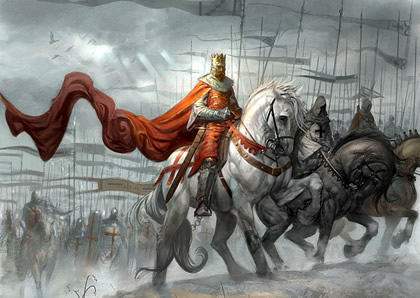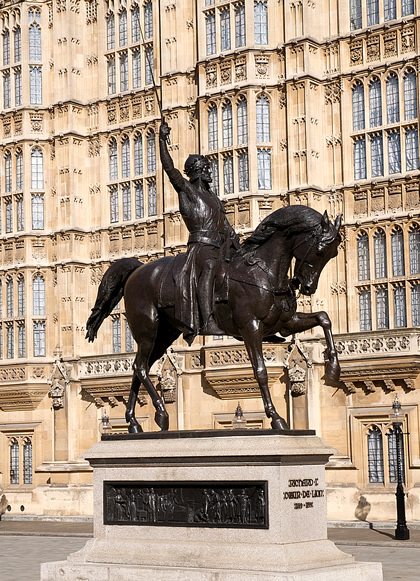World History
Richard I (r. 1189–1199) was the third son of King Henry II of England and Eleanor of Aquitaine. Known as “the Lionhearted†because of his numerous military exploits, Richard became king of England and Normandy when Henry II died in 1183.
Within a year he was leading forces on the Third Crusade. His goal was to return Jerusalem to Christian rule. Richard’s quest almost bankrupted the English treasury and led to increased taxes to pay for the expedition.
Arriving in Sicily Richard attacked Messini and after capturing the city, looted and burned it to the ground. He sailed to Rhodes, part of the Byzantine Empire, and traveled to the island of Cyprus. Richard’s larger and better equipped army soon defeated the rulers of Cyprus.
The crusaders then looted the island and massacred their opponents. While in Cyprus, Richard married his fiancée, Berengaria of Navarre. By his own choice Richard was frequently estranged from Berengaria and the marriage produced no children. Richard left no legitimate heir to the throne.
In the summer of 1191 Richard arrived at Acre to assist French and Austrian crusaders in their two-year siege of the city. He soon quarreled with the French King Philip II Augustus and after the city fell Philip returned to France.
Following their earlier pattern of conquest, Richard’s forces looted the city and killed many prisoners. However Richard was badly isolated and the strategy of “scorched earth†of Saladin (Salah ad din, Yusuf) left his army short of supplies.
Richard and Saladin, both keen military strategists, maneuvered over territories around Jerusalem and developed mutual respect for the other’s abilities. Recognizing that he would be unable to hold Jerusalem militarily, Richard agreed to a negotiated settlement in 1192 whereby the crusaders kept Acre and the Muslims kept Jerusalem.
Christian pilgrims were allowed access to the holy sites in the city. Eager to return to England, where rivals threatened his throne, Richard set sail for Europe but was shipwrecked off the coast of Venice.
He was captured and held hostage by Leopold of Austria and was only released in 1194 after the payment of an enormous ransom. He died from an arrow wound to the shoulder while fighting in Normandy in 1199.
- Eleanor Of Aquitaine
Eleanor of Aquitaine Eleanor of Aquitaine was born in 1122 to William X, duke of Aquitaine and count of Poitou, and Aenor, daughter of the viscountess of Châtellerault. At the death of her younger brother, Eleanor became the wealthy heiress of Aquitaine....
- Crusades
Crusades In 1095 Pope Urban II incited the Crusades with a speech urging Christian armies to free the holy sites, especially Jerusalem, from Muslim control. The Crusades sparked a fire of religious fervor among thousands of young knights and other Christian...
- Henry V - King Of England
Henry V - King of England Henry V of England and Agincourt was the son of Henry IV Bolingbroke, from the House of Lancaster, and Mary de Bohun, the daughter of the seventh earl of Hereford. At the age of 12, King Richard II knighted him as duke of Lancaster....
- Saladin (salah Ad Din, Yusuf )
Saladin after win a major military victory at the Battle of the Horns of Hattin Of Kurdish ethnicity, Saladin was born in Tikrit, Iraq, and was raised in northern Syria. After a religious education, he served with his uncle, Asad ad Din Shirkuh, for Abu...
- It Was Richard!
British archaeologists confirmed that the remains they found underneath a parking lot outside London are those of King Richard III. NPR did a story on it this afternoon. You can read more about it at the University of Leicester,whose archaeologists and...
World History
Richard I - King of England
 |
| Richard I leading forces on the Third Crusade |
Richard I (r. 1189–1199) was the third son of King Henry II of England and Eleanor of Aquitaine. Known as “the Lionhearted†because of his numerous military exploits, Richard became king of England and Normandy when Henry II died in 1183.
Within a year he was leading forces on the Third Crusade. His goal was to return Jerusalem to Christian rule. Richard’s quest almost bankrupted the English treasury and led to increased taxes to pay for the expedition.
Arriving in Sicily Richard attacked Messini and after capturing the city, looted and burned it to the ground. He sailed to Rhodes, part of the Byzantine Empire, and traveled to the island of Cyprus. Richard’s larger and better equipped army soon defeated the rulers of Cyprus.
  |   |
The crusaders then looted the island and massacred their opponents. While in Cyprus, Richard married his fiancée, Berengaria of Navarre. By his own choice Richard was frequently estranged from Berengaria and the marriage produced no children. Richard left no legitimate heir to the throne.
In the summer of 1191 Richard arrived at Acre to assist French and Austrian crusaders in their two-year siege of the city. He soon quarreled with the French King Philip II Augustus and after the city fell Philip returned to France.
Following their earlier pattern of conquest, Richard’s forces looted the city and killed many prisoners. However Richard was badly isolated and the strategy of “scorched earth†of Saladin (Salah ad din, Yusuf) left his army short of supplies.
 |
| Richard I statue |
Richard and Saladin, both keen military strategists, maneuvered over territories around Jerusalem and developed mutual respect for the other’s abilities. Recognizing that he would be unable to hold Jerusalem militarily, Richard agreed to a negotiated settlement in 1192 whereby the crusaders kept Acre and the Muslims kept Jerusalem.
Christian pilgrims were allowed access to the holy sites in the city. Eager to return to England, where rivals threatened his throne, Richard set sail for Europe but was shipwrecked off the coast of Venice.
He was captured and held hostage by Leopold of Austria and was only released in 1194 after the payment of an enormous ransom. He died from an arrow wound to the shoulder while fighting in Normandy in 1199.
- Eleanor Of Aquitaine
Eleanor of Aquitaine Eleanor of Aquitaine was born in 1122 to William X, duke of Aquitaine and count of Poitou, and Aenor, daughter of the viscountess of Châtellerault. At the death of her younger brother, Eleanor became the wealthy heiress of Aquitaine....
- Crusades
Crusades In 1095 Pope Urban II incited the Crusades with a speech urging Christian armies to free the holy sites, especially Jerusalem, from Muslim control. The Crusades sparked a fire of religious fervor among thousands of young knights and other Christian...
- Henry V - King Of England
Henry V - King of England Henry V of England and Agincourt was the son of Henry IV Bolingbroke, from the House of Lancaster, and Mary de Bohun, the daughter of the seventh earl of Hereford. At the age of 12, King Richard II knighted him as duke of Lancaster....
- Saladin (salah Ad Din, Yusuf )
Saladin after win a major military victory at the Battle of the Horns of Hattin Of Kurdish ethnicity, Saladin was born in Tikrit, Iraq, and was raised in northern Syria. After a religious education, he served with his uncle, Asad ad Din Shirkuh, for Abu...
- It Was Richard!
British archaeologists confirmed that the remains they found underneath a parking lot outside London are those of King Richard III. NPR did a story on it this afternoon. You can read more about it at the University of Leicester,whose archaeologists and...
